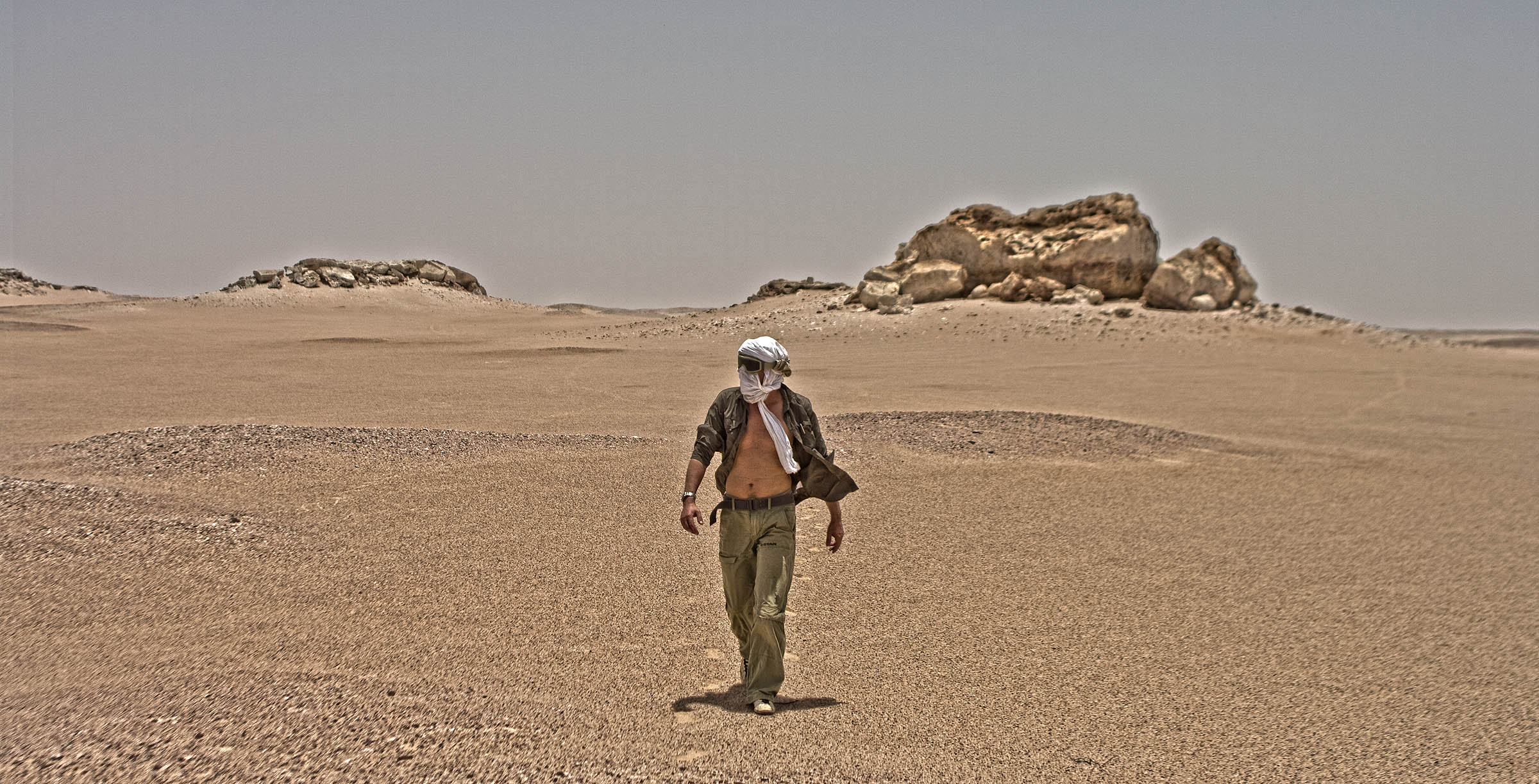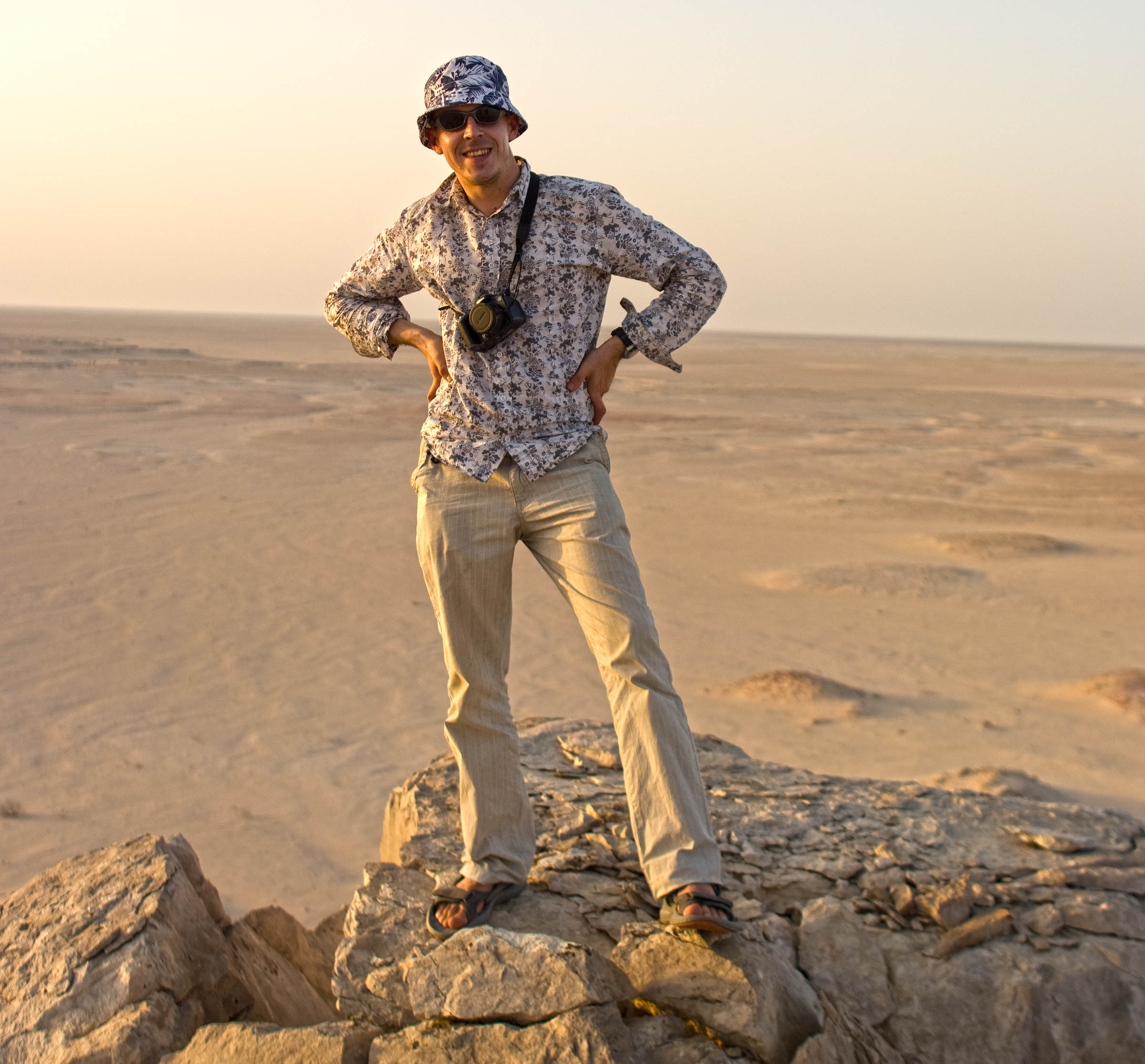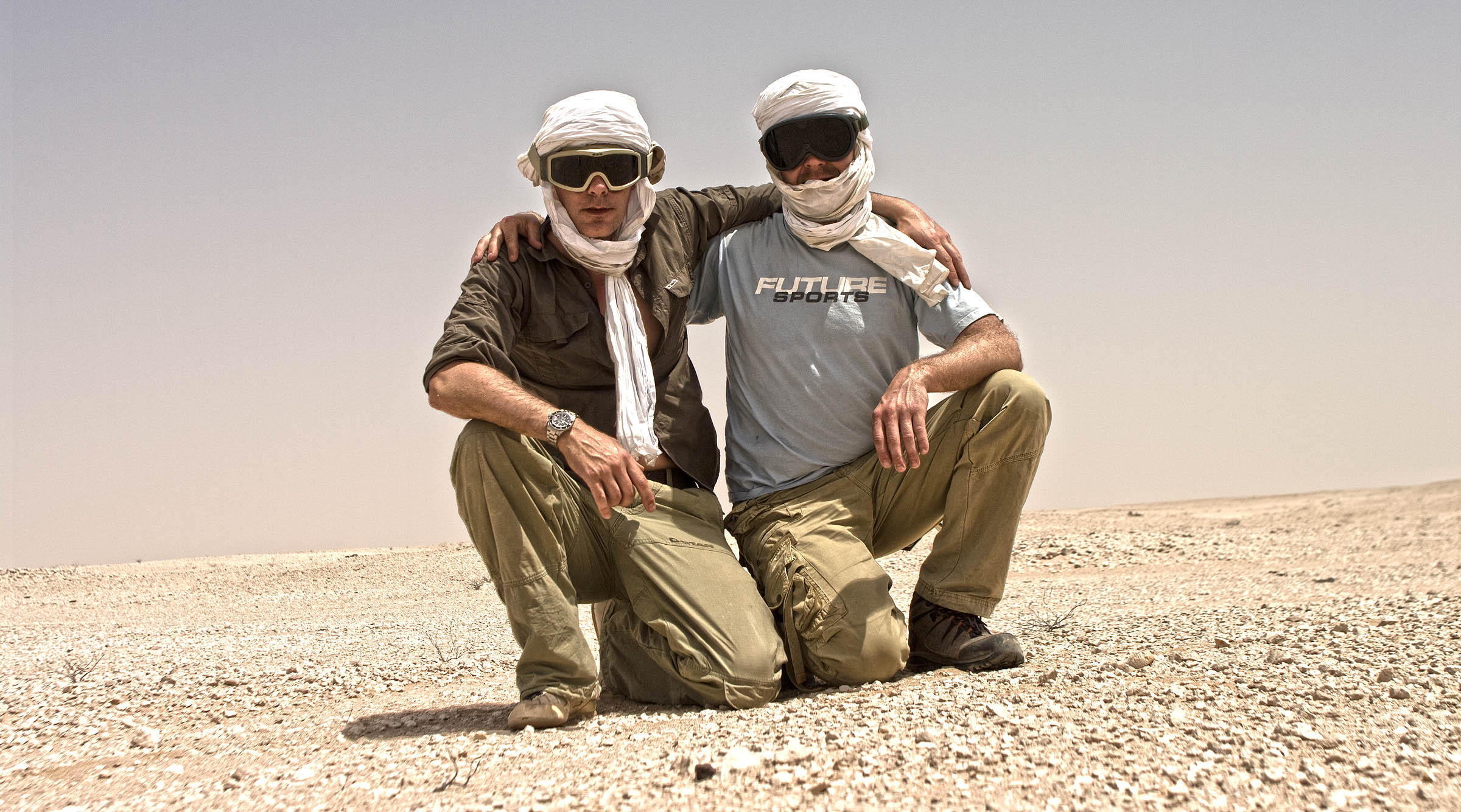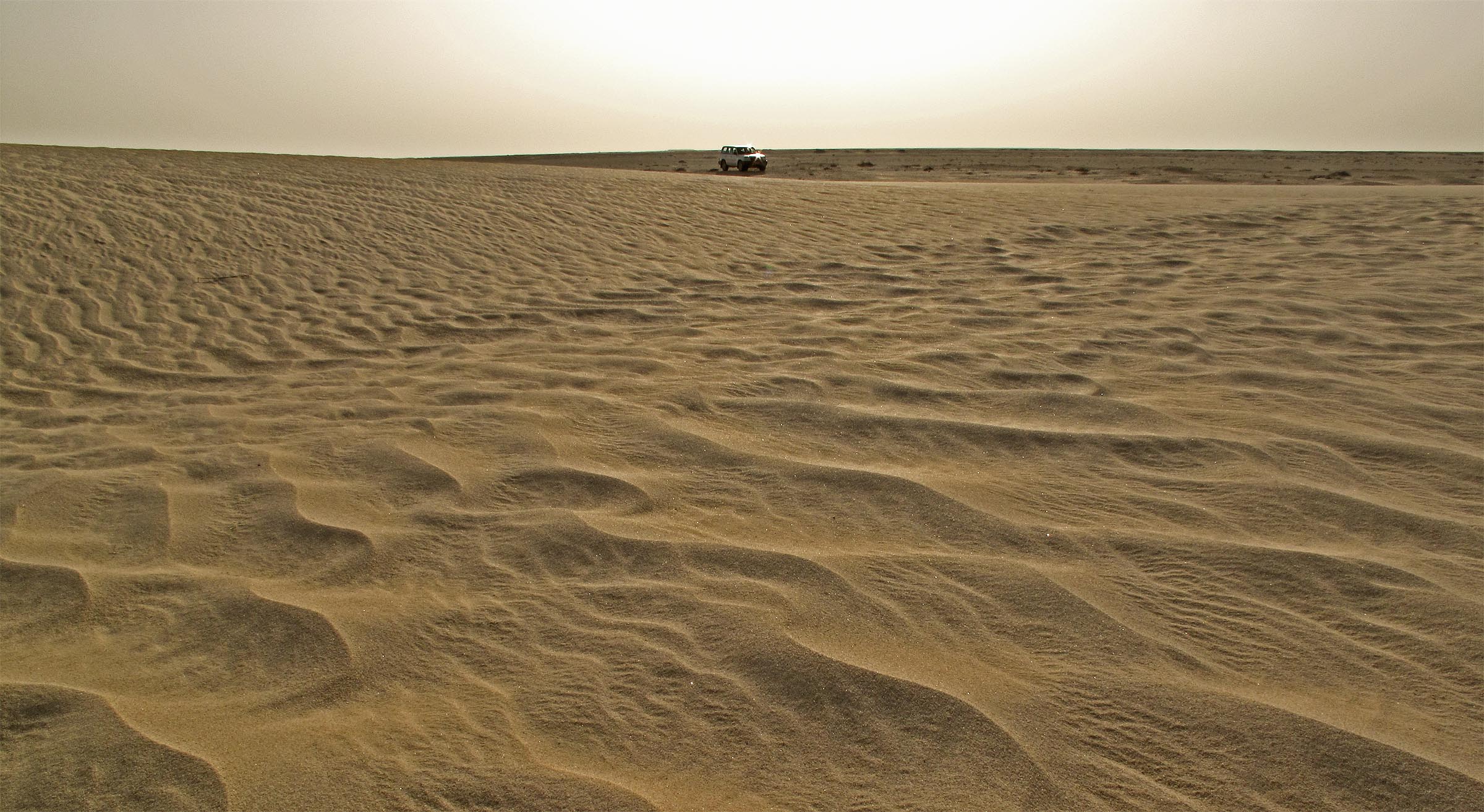My team mate Thomas, whom I took on board of this endeavour for his expert organisation skills and his modest and easy going demeanour, matched perfectly in the team. Because our Russian companions were unfamiliar with the name “Thomas”, he soon was renamed “Fantomas” after a 1964 French movie (“Men Hunt Him Down – Women Look Him Up – Master Lover!”), a film which obviously still enjoyed some popularity in Russia. Unless Fantomas wasn’t taking one of his famous afternoon naps he was a great entertainer, skilled navigator, vigilant scanner and expert meteorite spotter.
If you spend ten hours together in car each day under considerable physical and mental stress, things can go south pretty quick if you can’t bear the other’s presence. Fortunately the contrary was the case with my companion. He was game for anything and calmness itself, as long as he wasn’t battling a deflated kit mat.
When the other team arrived we were already searching the bright gravel plain in high spirits for about an hour. As we had not yet scored we agreed to continue the planned traverse which would by nightfall have lead us forty miles to the southeast. Until noon the sun would raise on the driver’s side which meant ideal spotting conditions for the co driver. In the late afternoon it would be the driver’s golden hours. To secure equal chances we changed frequently.
To prospect en route we fanned out our vehicles into a staggered column formation with a distance of 50 to 150 meters between each other, adapting speed and interspace to the respective terrain. On traverses like these leading us through unexplored ground, we had no particular target in mind other than certain surfaces characteristic for typical meteorite aggregation areas. Usually we would only stop for a more systematic search on occasion of a first cold find.
Only he, who ever had the privilege to see heavily loaded desert transport cruising endless seeming plains in parallel bearing, trailed by huge clouds of dust, under the crystal clear and deep blue desert morning sky, knows what a splendid delight such sight can be.
Because we had been successfully finding meteorites every day since we abandoned the road and advanced into the desert, we all were certain that the next find was only a matter of time. At 10:18 hrs this morning the spell was broken and the eagerly awaited moment had come. And as so often with meteorite searching, the awareness of a new find did not rise instantaneously but seeped in rather subtle.
Ivan Andreiev, our Russian companion
It was probably another small nodule of flint stone, or lydite perhaps, which I wanted to check. I had spotted it from the co-diver’s seat close to the car when Thomas cautiously circled around a shallow escarpment that suddenly appeared in our way. We stopped and as I got out of the shade the blazing sun hit me like a blow torch. On inspection the little rock lacked the usual conchoidal fractures and after the umpteenth pseudo meteorite for this day it took me a second or two until I realized, I had just found us another space rock.
The find wasn’t quite a meteorite to write home about, merely 15 grams, heavily weathered and quite unsightly, but it still was older than any rock on earth and had already travelled our solar system at times, when our own species wasn’t even in evolution’s pipeline. It was a good start for the day.
We searched the find location on foot for some time and continued to circle it by car with increasing distances. The find might represent a far end of a distribution ellipse or, given its size, could even have been transported to its resting place by ancient fluvial activity. In this case it would be nearly impossible to locate any associated material.
Small meteorite, happy finders. Author & T. Fuellengraben with a weathered 15 g chondrite
Two miles under way, we just climbed down the far side of scarp, I spotted the next one. “Stop” I yelled. This time there was no room for doubt, I knew it was a meteorite the instant the perfectly black spot emerged from the gravel bed. My broad smile told Thomas he hadn’t stopped in vain. While he took coordinates I grabbed the Pentax to photograph the stone in situ. I dropped to the floor to shoot some images at eye level but only to jump up like a bat out of hell because I had burned my bare arms on the red hot gravel. Only after preparing a cardboard sheet for insulation the documentation could continue.
In the following hours Thomas and I continued to find meteorites every five or six miles along the way. With four finds we had already gained quite a head start compared to the single find of our second team. With some pleasure, I have to admit, we noticed a beginning uneasiness with our Russian friends about our increasing finds. We knew this feeling just too well from the previous day; we just had changed places with them.
A normal work day conisted of eight hours of driving – if the tires held this long
The time spent searching in the car was never dull. Working in a well rehearsed two man team made things easy and entertaining. A virtual passenger probably could not have made head or tail of our conversation, to us, after eight days of search routine, it was the talk of our trade:
“One o’clock, eighty meters, in front the bump, see that?”
“Yep. Too bright. But one thirty, hundred meters, see this?”
“Yea, it’s a root.”
“You sure?”
“Here, check!” (handing binoculars)
“Yea, you’re right. And what’s this, fifty on your side?”
“Not black enough.”
“Ok … but you see these two just twenty meters right of that butte at two thirty far?”
“Hardly, but looks good to me, lets drive there.”
” … where are they now, I lost ’em.”
(fumbling with binoculars) “One thirty, got ’em again, but it’s just shadow.”
“Then lets go on, keep the sun at our six. Wait, wait, … wow, see that big one dead ahead far? Get us there, thats a premium target.”
“Could be a can, hard to tell from this distance.”
“Yep, looks almost too good. … is it …?
” “No, isn’t a can … but still could be a …” (car stops, getting out) “Ouch, mind the metal, it’s hot like a stove. Mhm, nope, just a chunk of flint.”
“Fine, then lets continue.”
“Watch out that fesch fesch deposit, we’ll sink if you cross that gypsum plain.”
“Relax, we have enough momentum.”
“You bog that car down, you push it out.”
“Negative, you’re the assistant driver on duty.”
“I give you assistant driver …”
“Better get us some water, I’m drying out.”
(pouring water, steel cups clattering) “Dang, not all over my trousers you wastrel …”
“Well, no wonder, you’re driving like a bloody maniac …”
“Cheers mate! (clang of cups)”
“Hey?! saw this one?”
“Sure I saw it … almost ran over it, hold on, I’ll turn.”
“Batten the hatches!”
(coughing) “Too late. Now you might as well leave ’em down, somehow all this dust has to get out again.” (more coughing)
“Where’s it now, I see nothing in this cloud.”
“Must have been somewhere here.”
“No, it was further back … wait, here it comes. I’ll go and check. Where’s the bloody magnet?” (jumps out of the car, returns) “Nope, Bakelite.”
“Bakelite?”
“Yep, Bakelite, or whatever you call this rock we keep finding all day.”
” … oh, lydite.”
“Yeah mate, that’s what I’m telling you.”
“Good, back on track then.” (engine roaring)
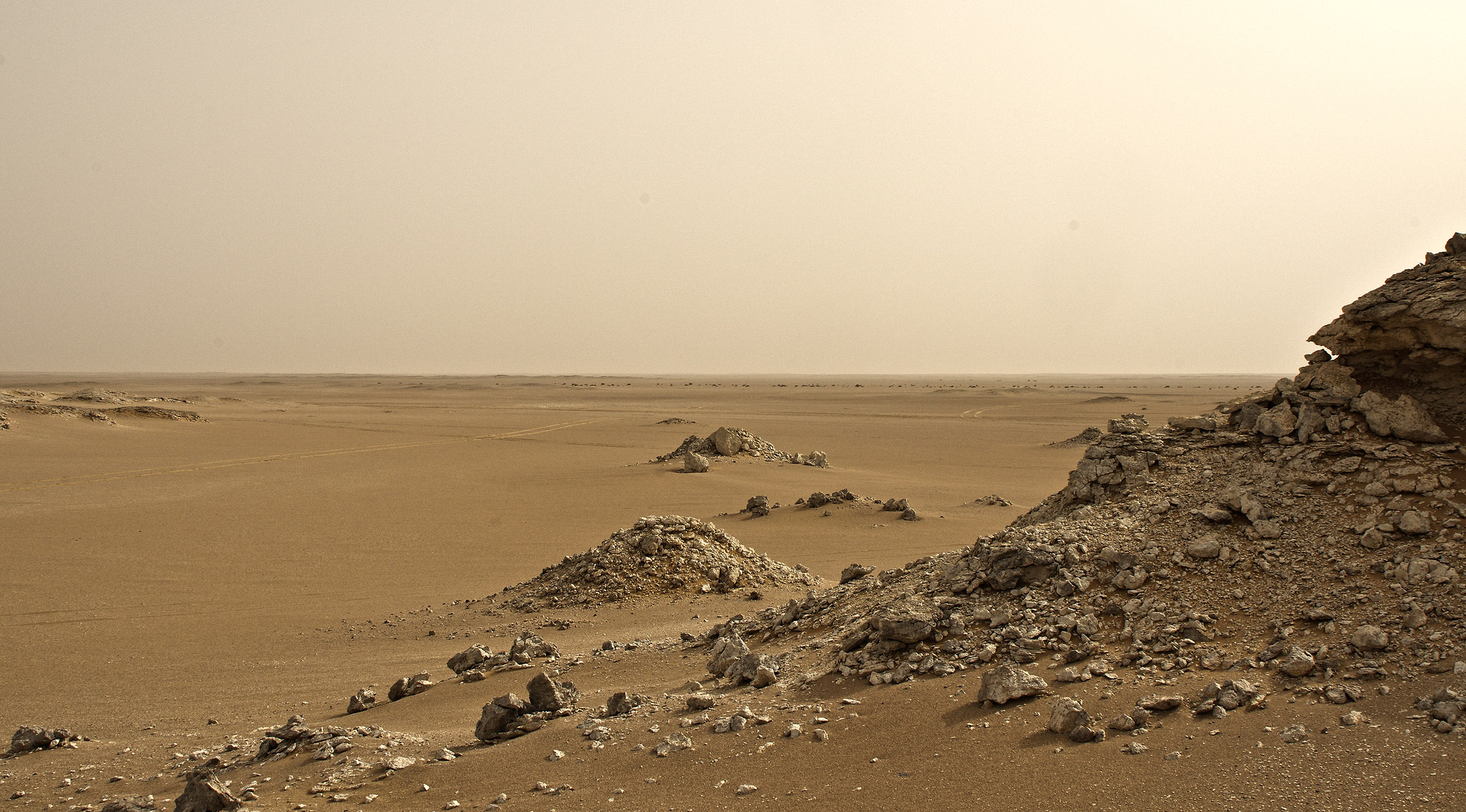
Following the tracks of our 2nd vehicle
Our fifth find this day was quite unusual. We were crossing a vast area of red sand with single patches of bright gravel, but since a couple of kilometres searching was no longer possible due to an increasing amount of black lydite weathering out of the ground. Dark lumps of it were abundantly spread on the surface in large clusters.
Lydite is a dark grey or black variant of radiolarite or radiolarian chert, a microcrystalline high silica sedimentary rock which is formed as primary deposits and contains radiolarian microfossils. Often it is coated with a dark grey or black desert patina, particularly if the fragments are exposed on the surface for a long time.
A lump of lydite weathering out the bed rock will move upwards through the silt and start to break up on the surface over the millennia. A single outcrop can spread its fragments over several hundred meters making the area impossible to search for meteorites, as these will look exactly the same, even from closer distances.
More than once I spotted a single black rock on my driver’s side kicking the breaks, only to see Thomas nod to the other side of the car where literally thousands of similar fragments were spread as far as the eye could see. After several such pulse quickening interludes we decided that this made no sense and stopped prospecting. It was obvious that we had to speed up and get across the uncooperative surface as quickly as possible, if we wanted to catch up with our current streak of luck. Our Russian friends were similarly frustrated by the terrain and soon both our vehicles were dashing south, trailed by a dust cloud that would have been the envy of a decent tank battalion.
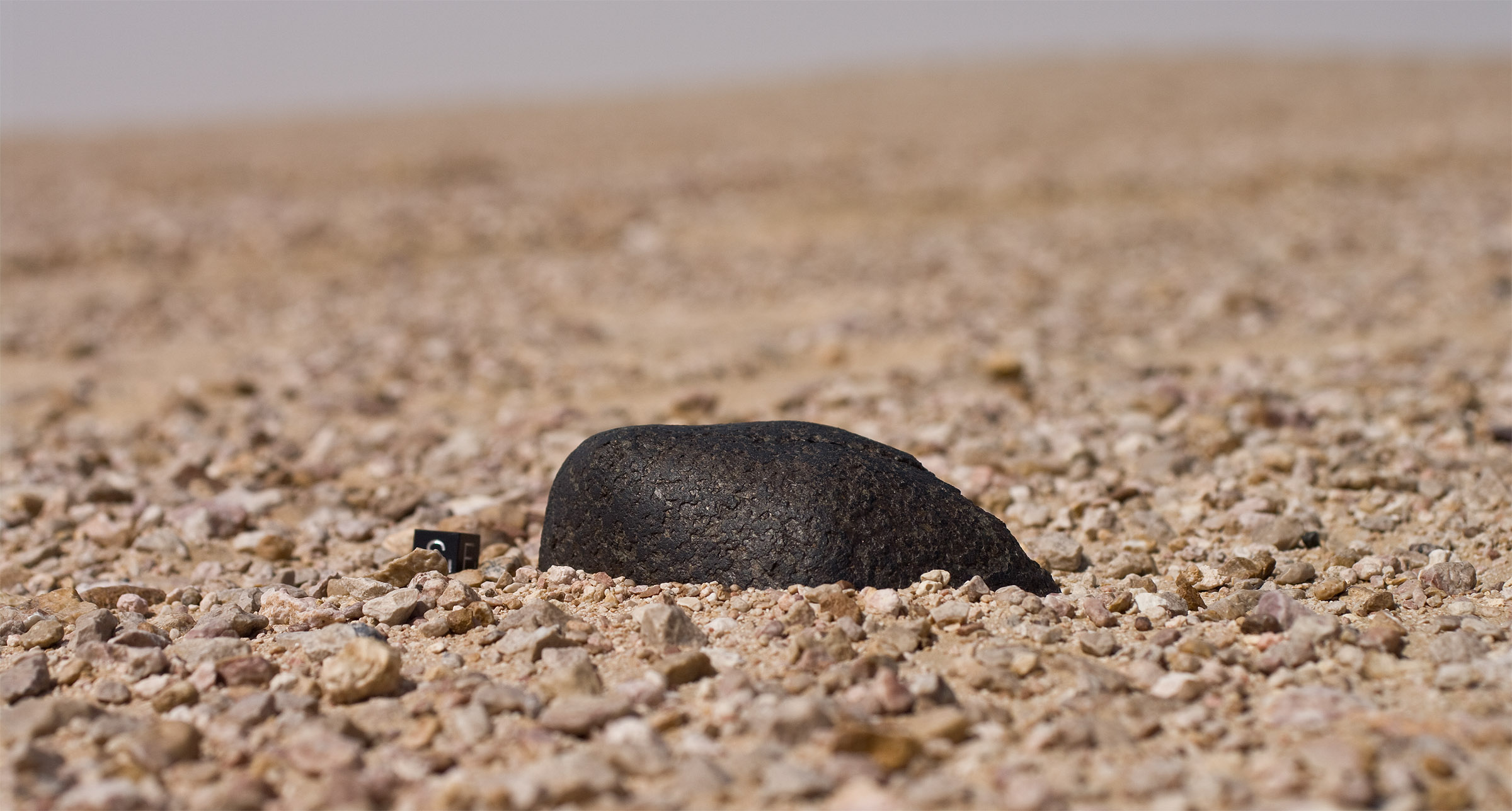
Strike! Ureilite meteorite in situ. Scale cube is 1 cm
However, the attraction imminent to dark rocks on a bright desert floor is hard to ignore, even temporarily. With a force against which gravity is merely the puff of a snow flake, the true meteorite prospector is pulled to these potential targets like a moth to a flame. Despite the irrationality of the undertaking, we caught us several times abandoning our bearing or driving reverse circles to inspect a particularly tempting target – of course only to discover yet another striking meteorite look alike.
It was on occasion of one of these turns when we lost orientation for a moment and stopped to look around in the settling dust in search for the second car. Suddenly we both, in the same instant, spotted a larger solitary dark rock just a few paces in front of the vehicle. “There!” we exclaimed simultaneously. I brought the car to a halt, jumped out and walked towards the stone that seemed to emerge from the gravel like a surfaced whale. With the coarse textured black patches of fusion crust there was no more room for doubt, for sure this was a meteorite, and what a beauty.
“Strike” I called to Thomas, who already was hacking the new coordinates into a GPS. From our trunk I grabbed the thick slide of cardboard I had fabricated just for this purpose and lowered myself on the ground at eye level with the meteorite. Careful not to burn my bare arms on the red hot rocks while preparing my camera I focussed the new find. It had the shape of a pot whale with its fluke still submerged. Even the mouth was resembled in shape of a long crack along which the fusion crust had been abraded by sand, thus bringing out the brighter interior of the meteorite like a row of whalebone. Such striking zoomorphic shapes usually only occur with iron meteorites and I wondered how much of it was in the eye of the beholder.



